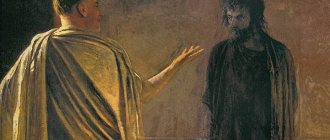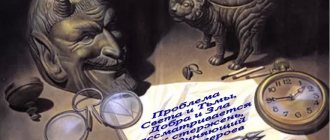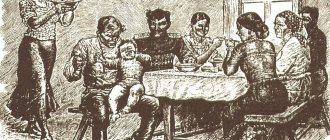- Essays
- On literature
- Bulgakov
- Characteristics and image of Margarita in the novel The Master and Margarita
Margarita is one of the key figures in M. Bulgakov’s novel. The Master's muse and beloved, whom he dreamed of and whom he had been waiting for for so long. The meeting of the heroes radically changes their lives.
Margarita, despite her prosperous and prosperous life, is deeply unhappy. She is married to a man who loves her, but he is not loved by her. Margarita's life before meeting the Master can be described as a period of waiting; the heroine seems to feel that she is destined to live a different, more interesting life and play a particularly important role in the fate of another person.
The first meeting of the heroes seems to be predetermined from the very beginning of their lives, here is their meeting in a deserted alley, and their love at first sight. The heroine is sure that the feeling of love for each other arose a very long time ago, when the heroes did not yet know each other.
Margarita becomes a muse for her lover, inspires him to write a novel and later, after reading the first pages of the novel he created, gives him the nickname “Master,” thereby recognizing his genius.
The image of Margarita in the novel by M. Bulgakov embodies strength and faith, the heroine is ready to go to the end for the sake of her Master, support him in every possible way and instill confidence in a better future. She has incredible willpower.
The Master's novel, after publishing several chapters, was criticized and then destroyed by its creator. Hard times are coming for Margarita - the Master leaves her, voluntarily going to a mental hospital. Margarita is unhappy, her life is losing color, this period can safely be called existence.
Her encounter with evil spirits gives her hope. For the opportunity to find out about the fate of her lover, Margarita goes to Satan, and then to a ball, where she has to experience physical and mental torment. Woland is admired by the heroine’s devotion and fortitude, he frees the Master and gives him peace, Margarita, always faithful to her love, follows him, ready to share his fate with the Master.
The image of Margarita in M. Bulgakov’s novel is the embodiment of love, devotion and femininity. The heroine's spiritual strength will conquer and delight more generations of readers.
Essay about Margarita
Bulgakov wrote his novel “The Master and Margarita” under the impression of Goethe’s “Faust,” which greatly impressed him. Even the name of the main character, Margarita, is the full name from the European abbreviation of Gretchen, the heroine and lover of Faust. But in all other respects these images diverge.
Margarita Bulgakova is an image that evokes sympathy, sympathy and outright admiration. This is a young girl who, at the age of 19, was already married, but having met the Master, she realized that her life before that was meaningless. Bulgakov makes yellow flowers, which are in Margarita’s hands at the moment of meeting the Master, as a symbol of farewell to her past life and her husband. Yellow flowers are a sign of parting with something. By the way, Bulgakov does not describe Margarita’s appearance; he limits himself to the fact that she has “loneliness in her eyes.” Loneliness despite the fact that she was married at the time of the meeting. Her marriage was so empty for her that her eyes gave her away. And this provided that her husband really loved her, he allowed her to buy whatever she wanted and do whatever came into her head. But this was not mutual, as Margarita herself finds out after meeting the Master.
Margarita falls in love with the Master almost immediately, and her love is as disinterested, sacrificial, sincere and angelically pure as possible. For the sake of her beloved, in order to be with him, she does the most unthinkable things: she becomes a witch, gets involved with Woland, attends the devil’s ball, renounces her prosperous life. And her sacrifice is rewarded with eternal peace with the Master.
The Master himself would never have been able to write his novel without Margarita, she is his main assistant against the opinion of the narrow-minded MASSOLIT writers who criticize the Master and his creation, because of which he burns the novel, because the Master is weak , while Margarita strong _ And it is precisely this strength of character, the desire to help his beloved that supports their love, because the Master is a characterless person, and Margarita seems to be his support in everything, his guide, his star that guides him in the dark night.
Can we say that Margarita has only positive traits? No, I don't think it's possible. She lies to her husband, not telling her that she leads a different life, that she is dating another man. This lie torments her, she cannot live peacefully with him, therefore, becoming a witch, she leaves a letter to her husband in which she confesses everything. And only after this she feels relief and her conscience is largely cleared, and Margarita herself finds peace.
Transformation into a witch
At the first meeting , Woland appreciated the determination and intelligence of the heroine . She had an inner sense, thanks to which she was immediately able to understand what kind of person was in front of her. The girl always helped those in need and never wasted words.
The image of Margarita is a symbol of a loving and beloved girl who was ready to do anything for the sake of a loved one. This is a sincere, faithful and energetic woman. This is exactly what the Master lacked. For his sake, she made a deal with the devil.
The reader learns about the heroine’s life before meeting the Master from the words of the girl herself. She didn't need material wealth. She needed real feelings.
The house in which the heroine lived seems like an ordinary cage . The grayness of days kills a woman’s rich inner world and her broad soul.
After meeting the Master, the heroine is greatly transformed, as she finally has meaning in her life. She directs all her energy to her beloved and his manuscript. Now even ordinary household work brought her joy.
The Master's novel was criticized and refused to be published . This made the girl furious. Then Azazello, Woland’s envoy, came to her and offered a deal. Now the woman appears before the reader in a completely new image. Margarita from “The Master and Margarita” turns into a witch, ready to get even with all her offenders.
Bulgakov does not spare colors when describing the image of a witch. She removes everything that once hindered her breathing and prevented her from living.
Option 3
The image of Margarita in Bulgakov’s work “The Master and Margarita” is quite simple, but at the same time extremely mysterious. Let's figure out together how this can be and why I think this image is full of contradictions.
Margarita has enough of everything in life, she does not experience financial difficulties and even serves as an object for some to have. Margarita is the wife of a responsible worker who fully provides for his wife. In order to have a lot of free time and not bother herself, Margarita even has a housekeeper, Natasha, at her disposal. The hostess treats her servants very well and their relationship even looks like friendship.
Margarita has too much time to think. The woman clearly had nothing to occupy herself at the time when, wandering aimlessly down the street with a bouquet of yellow flowers, she first met her Master.
Meanwhile, the woman is very lonely and lacks love and warmth. The meeting with the Master, as she later calls her lover for his talent as a writer, opened up new sensations for her. Margarita began to become attached to the Master, who showed her a lot of attention and gave her all his unspent warmth and love. She felt good and comfortable next to him, being next to her lover in his small bachelor apartment. She listened with pleasure to his own opuses, which her lover read to her. This went on for quite some time until the Master wrote a work on a forbidden topic, which seemed to Margarita a true masterpiece. No publishing house agreed to publish the manuscript. Margarita had to be persistent in order for one of the publishing houses to publish an excerpt from the Master’s work. She wanted the whole world to recognize the talent of her lover, but the publication of the excerpt was the beginning of the end - critics began to scold the author and his work, showering the Master with unflattering epithets.
The attacks on her lover infuriated Margarita, and the Master became despondent and suffered from a mental disorder. Realizing that he is going crazy, the unfortunate writer burns his manuscript and leaves Margarita so as not to hurt her and no longer upset her with his mental state, because he was getting worse day by day. He voluntarily goes to a psychiatric hospital, hoping that Margarita will forget him over time and will no longer suffer. The master gave up, recognizing himself as a failure and abandoning his beloved.
But Margarita did not forget her Master. Now she began to devote all her energy and time to searching for her missing lover. To find him, she even agrees to become the prom queen of Satan himself.
Margarita has a narrow moral framework; she wants freedom. She wants to shake herself up, so as not to think about bad things, not to miss her lover anymore, she wants to add new meaning to her life, even if the devil himself offers her the most extraordinary and forbidden methods to change the boring life routine. Having become a witch of her own free will, the first thing Margarita begins to enjoy is the feeling of unprecedented freedom.
Margarita decides to ask Satan himself for a meeting with the Master. Even the devil, along with admiration, should awaken respect for such sacrifice, which Margarita embodies in her image. He grants her request, taking the Master and Margarita under his hellish command forever.
Popular writings
- Essay based on the story by Biryuk, grade 7 (Turgenev)
This story surprises and keeps you in suspense until the end. The tension grows, and at the very last moment it turns out that Biryuk is a “nice fellow.” Of course, this story is about him – about his interesting character. - There is such a profession - to defend the Motherland - essay (2, 3, 5, 6, 10, 11 grades)
Our powerful power is rich in its colossal wealth - the Russian Federation is spread over vast territories, in its depths there are Russian forests of incredible beauty, in the soil contains something unprecedented - Composition by Luzhin in the work Crime and Punishment (Image and Characteristics)
Luzhin is the hero of the work “Crime and Punishment” by Dostoevsky. Most readers compare him with another hero, Raskolnikov, because they are somewhat similar in the field of theory.
Characteristics of Margarita
Margarita in M.A. Bulgakov’s novel “The Master and Margarita” is the main character, the image of the ideal woman as Bulgakov saw her: capable of feats, sacrifice and courage. The prototype for Margarita is the writer’s beloved wife, Elena Sergeevna, so in the description of his heroine he puts so much of his own soul, all the love and admiration for a woman ready for great achievements and virtue in the name of love.
Despite the fact that Margarita is a young and very beautiful girl, at the beginning of the novel she appears to us as the most unfortunate of women. Despite the fact that the heroine is married and her husband is rich, that she has the right not to deny herself anything, the girl is burdened by her fate and is tormented by the greatest loss: her beloved Master has left her life. He disappeared and did not come back, no matter how Margarita called him or tried to find him.
The heroine throws all her spiritual strength into searching for her lover, in which she is helped by Azazello, sent to her by Woland. Communicating with the messenger of Satan, Margarita understands that she is taking a terrible risk by agreeing to his conditions, but the heroine knows for sure that Azazello knows something about the Master, and therefore she agrees to any of her conditions. This girl is an example of true heroism in love.
The master is poor, sick and suffers attacks from critics on his literary work. He is convinced that Margarita deserves more, but nothing more than being next to him makes her happy, so she agrees to live in the basement if this is a condition for her happiness with the Master. The phrase about love uttered by Woland refers specifically to Margarita: “He who loves must share the fate of the one he loves.”
At Satan's ball, the heroine appears in the guise of a queen. The author deliberately points us to Margaret's noble origins, associated with the French kings. That is why Woland’s choice among all the Margaritas of Moscow stops at our heroine. At the ball we learn that Margarita’s omnipotent love extends not only to the Master. This caring and sensual girl empathizes with everyone around her, helping first Woland and then the unfortunate Frida. Margarita's kind heart, her dedication, and purity of soul are highly valued by Woland, the girl is sincerely loved by his entire retinue.
So, in the image of Margarita, M.A. Bulgakov strives to embody the ideal of a woman, morally elevated and pure, and at the same time incredibly brave and strong.
See you with the master
Before meeting the master, Margarita's life was completely empty and aimless.
“She said...” says the master about their first meeting, “that she came out with yellow flowers that day so that I would finally find her.” Otherwise, Margarita “would have been poisoned, because her life is empty.” The heroine married a rich and respected man at the age of 19. The couple lived in a beautiful mansion, a life that any woman would be happy with: a cozy home, a loving husband, lack of household worries, Margarita “didn’t know what a Primus stove was.” But the heroine “wasn’t happy for a day.” Very beautiful. The young woman sees no purpose or meaning in her philistine life. It’s hard, boring and lonely for her in her mansion, which is increasingly looking like a cage. Her soul is very broad, her inner world is rich, and she has no place in the gray, boring world of ordinary people, to which her husband apparently belonged.
Amazing beauty, lively, “slightly squinting eyes” in which “extraordinary loneliness” shone - this is the description of Margarita in the novel “The Master and Margarita”.
Her life without a master is the life of an insanely lonely, unhappy woman. Having unspent warmth in her heart and irrepressible energy in her soul, Margarita did not have the opportunity to direct it in the right direction.
Determination and courage
Bulgakov's Margarita is decisive, courageous and capable of fighting for her love to the end. In the last chapters of the novel, it turns out that her chosen one has lost heart, depriving himself of the right to light. He abandoned his love and regretted writing the novel.
As a reward for the novel, the Master received peace and Margot, as he himself called her. Remaining devoted to her lover, she voluntarily goes with him to the kingdom of eternal peace.
By creating an artistic image of Margarita, Mikhail Bulgakov tried to show the world his own understanding of the female ideal . The value of a work of art is determined not by the criticism of contemporaries, but by the attitude of descendants towards it. The fate of Mikhail Bulgakov’s novel “The Master and Margarita” fully confirms this.









